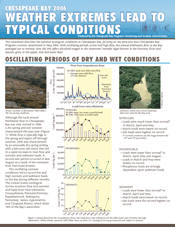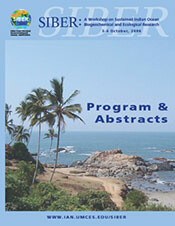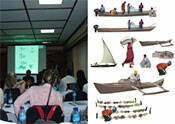Climate change synthesis
The U.S. Environmental Protection Agency is funding the production of a synthesis document as part of the U.S. Climate Change Science Program. This document will review the management options for climate-sensitive ecosystems, including marine protected areas, estuaries, wild and scenic rivers, national parks, national forests, and national wildlife refuges. A series of seven 2-3 day workshops with seven lead authors, over thirty co-authors and dozens of stakeholders will be held at the IAN Annapolis Synthesis Center in December and January. Case studies will be developed for each ecosystem type and the management options for responding to climate change will be reviewed. Margaret Palmer will serve as lead author of the wild and scenic rivers chapter, and Bill Dennison will facilitate the stakeholder meetings and serve as the coordinating author.Weather extremes lead to typical conditions (Summer lookback newsletter)
 EcoCheck (NOAA-UMCES Partnership) in collaboration with the Chesapeake Bay Program has produced a newsletter, 'Weather extremes lead to typical conditions'. The newsletter addresses the extreme weather conditions that the Bay area experienced during the spring and summer of 2006 and how these weather conditions affected the summer ecological forecast that was released in May 2006 and other aspects of Bay health. The forecast focuses on dissolved oxygen in the mainstem, harmful algal blooms in the Potomac River and aquatic grasses in three locations in the Bay. Scientists have been tracking these conditions through the summer to provide an assessment of summer conditions and to evaluate the forecast.
EcoCheck (NOAA-UMCES Partnership) in collaboration with the Chesapeake Bay Program has produced a newsletter, 'Weather extremes lead to typical conditions'. The newsletter addresses the extreme weather conditions that the Bay area experienced during the spring and summer of 2006 and how these weather conditions affected the summer ecological forecast that was released in May 2006 and other aspects of Bay health. The forecast focuses on dissolved oxygen in the mainstem, harmful algal blooms in the Potomac River and aquatic grasses in three locations in the Bay. Scientists have been tracking these conditions through the summer to provide an assessment of summer conditions and to evaluate the forecast.
National Park Service Showcase for Science
 The partnership between IAN and the Inventory and Monitoring (I&M) program in the National Capital Region Network of national parks sponsored a Showcase for Science. The two day workshop was held Oct 26-27 at the National Conservation Training Center in Shepherdstown, West Virginia. The first day, attended by park resource managers, highlighted a 12-posters series describing park-based monitoring activities and proposed management thresholds for a subset of network vital signs or ecological indicators. The second day included a discussion with park superintendents on how the inventory and monitoring information can be best incorporated into park planning and management activities.
The partnership between IAN and the Inventory and Monitoring (I&M) program in the National Capital Region Network of national parks sponsored a Showcase for Science. The two day workshop was held Oct 26-27 at the National Conservation Training Center in Shepherdstown, West Virginia. The first day, attended by park resource managers, highlighted a 12-posters series describing park-based monitoring activities and proposed management thresholds for a subset of network vital signs or ecological indicators. The second day included a discussion with park superintendents on how the inventory and monitoring information can be best incorporated into park planning and management activities.
Workshop on Sustained Indian Ocean Biogeochemical and Ecological Research (SIBER)
 On October 3-6, the Workshop on Sustained Indian Ocean Biogeochemical and Ecological Research (SIBER) assembled over 175 scientists at the National Institute of Oceanography in Goa, India to formulate a plan for the implementation of a biogeochemical and ecological observational and modeling research program in the Indian Ocean. Raleigh Hood from the Horn Point Laboratory was the workshop Chair, and Wajih Naqvi of the National Institute of Oceanography, the co-Chair. Jane Hawkey of the Integration & Application Network (IAN) was responsible for the overall organization of the workshop, including travel arrangements, keynote speaker and poster presentations. The IAN designed and hosted SIBER website handled online registrations and abstract submissions, and will soon be used to post the SIBER keynote talks and workshop proceedings.
On October 3-6, the Workshop on Sustained Indian Ocean Biogeochemical and Ecological Research (SIBER) assembled over 175 scientists at the National Institute of Oceanography in Goa, India to formulate a plan for the implementation of a biogeochemical and ecological observational and modeling research program in the Indian Ocean. Raleigh Hood from the Horn Point Laboratory was the workshop Chair, and Wajih Naqvi of the National Institute of Oceanography, the co-Chair. Jane Hawkey of the Integration & Application Network (IAN) was responsible for the overall organization of the workshop, including travel arrangements, keynote speaker and poster presentations. The IAN designed and hosted SIBER website handled online registrations and abstract submissions, and will soon be used to post the SIBER keynote talks and workshop proceedings.
ISBW 7 Conference 2006
 On September 10-15, Tim Carruthers from the IAN group attended the seventh International Seagrass Biology Workshop (ISBW7) in Zanzibar, Tanzania. Tim gave a presentation on work being carried out with an NCEAS (National Center for Ecological Analysis and Synthesis) project on Global Seagrass Trajectories, entitled “A Global Crisis for Seagras Ecosystems?”. He also gave a short workshop on techniques in effective science communication.
On September 10-15, Tim Carruthers from the IAN group attended the seventh International Seagrass Biology Workshop (ISBW7) in Zanzibar, Tanzania. Tim gave a presentation on work being carried out with an NCEAS (National Center for Ecological Analysis and Synthesis) project on Global Seagrass Trajectories, entitled “A Global Crisis for Seagras Ecosystems?”. He also gave a short workshop on techniques in effective science communication.

